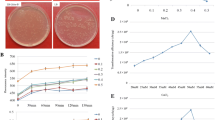Abstract
Large molecular weight plasmids are often used in gene therapy and DNA vaccines. To investigate the effect of plasmid size on the performance of Escherichia coli host strains during plasmid preparation, we employed E. coli JM109 and TOP10 cells to prepare four plasmids ranging from 4.7 to 16.8 kb in size. Each plasmid was extracted from JM109 and TOP10 cells using an alkaline lysis mini-preparation method. However, when commercial kits were used to extract the same plasmids from JM109 cells, the large molecular weight plasmids substantially degraded, compared with their smaller counterparts. No degradation was observed when the four plasmids were extracted from E. coli TOP10 cells using the same commercial kit. We conclude, therefore, that the performance of E. coli in high quality plasmid preparations can be affected by plasmid size.




Similar content being viewed by others
References
Aertsen A, Tesfazgi Mebrhatu M, Michiels CW (2008) Activation of the Salmonella typhimurium Mrr protein. Biochem Biophys Res Commun 367(2):435–439
Beary TP, Braymer HD, Achberger EC (1997) Evidence of participation of McrB(S) in McrBC restriction in Escherichia coli K-12. J Bacteriol 179(24):7768–7775
Bower DM, Prather KL (2009) Engineering of bacterial strains and vectors for the production of plasmid DNA. Appl Microbiol Biotechnol 82(5):805–813
Carnes AE (2005) Fermentation design for the manufacture of therapeutic plasmid DNA. BioProcess Int 3(9):36–44
Hanahan D (1983) Studies on transformation of Escherichia coli with plasmids. J Mol Biol 166(4):557–580
Kutzler MA, Weiner DB (2008) DNA vaccines: ready for prime time? Nat Rev Genet 9(10):776–788
Levison PR, Badger SE, Dennis J, Hathi P, Davies MJ, Bruce IJ et al (1998) Recent developments of magnetic beads for use in nucleic acid purification. J Chromatogr A 816(1):107–111
Levy MS, Collins IJ, Ward JM, Titchener-Hooker N, Ayazi Shamlou P, Dunnill P (1999) Effect of shear on plasmid DNA in solution. Bioprocess Eng 20:7–13
Liang QL, Wang BR, Li ZY, Chen GQ, Zhou Y (2011) Construction of eukaryotic expression vector of TSLC1 gene. Arch Med Sci 7(4):579–585
Limor R, Gilad S, Kutikof E, Jaffe A, Tendler Y, Gazit V et al (1999) Contaminant eluted from solid-phase plasmid affinity-purification protocol columns is not found using liquid-phase methods and can be prevented. J Biochem Biophys Meth 40(1–2):57–64
Maulik N (2009) NV1FGF, a pCOR plasmid-based angiogenic gene therapy for the treatment of intermittent claudication and critical limb ischemia. Curr Opin Investig Drugs 10(3):259–268
Mulligan EA, Dunn JJ (2008) Cloning, purification and initial characterization of E. coli McrA, a putative 5-methylcytosine-specific nuclease. Protein Expr Purif 62(1):98–103
Nakata Y, Tang X, Yokoyama KK (1997) Preparation of competent cells for high-efficiency plasmid transformation of Escherichia coli. Methods Mol Biol 69:129–137
Phue JN, Lee SJ, Trinh L, Shiloach J (2008) Modified Escherichia coli B (BL21), a superior producer of plasmid DNA compared with Escherichia coli K (DH5α). Biotechnol Bioeng 101(4):831–836
Schoenfeld T, Mendez J, Storts DR (1995) Effects of bacterial strains carrying the endA1 genotype on DNA quality isolated with wizard (TM) plasmid purification systems. Promega Notes 53:12–19
Taylor RG, Walker DC, McInnes RR (1993) E. coli host strains significantly affect the quality of small scale plasmid DNA preparations used for sequencing. Nucleic Acids Res 21(7):1677–1678
Yanisch-Perron C, Vieira J, Messing J (1985) Improved M13 phage cloning vectors and host strains: nucleotide sequences of the M13mp18 and pUC19 vectors. Gene 33(1):103–119
Yau SY, Keshavarz-Moore E, Ward J (2008) Host strain influences on supercoiled plasmid DNA production in Escherichia coli: implications for efficient design of large-scale processes. Biotechnol Bioeng 101(3):529–544
Acknowledgments
This work was supported by the Natural Science Foundation of Zhejiang Province in China (Grant No. Y2111122), and the Medical and Health Research Program of Hangzhou in China (Grant No. 20110833B33).
Author information
Authors and Affiliations
Corresponding author
Rights and permissions
About this article
Cite this article
Yang, J., Yang, Y. Plasmid size can affect the ability of Escherichia coli to produce high-quality plasmids. Biotechnol Lett 34, 2017–2022 (2012). https://doi.org/10.1007/s10529-012-0994-4
Received:
Accepted:
Published:
Issue Date:
DOI: https://doi.org/10.1007/s10529-012-0994-4




